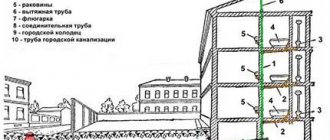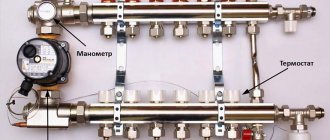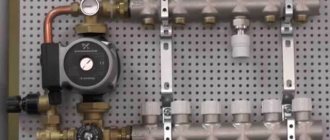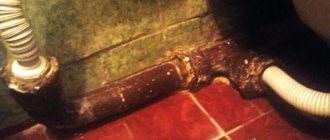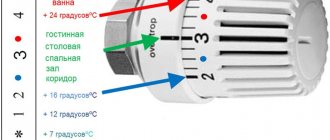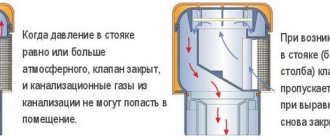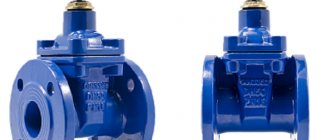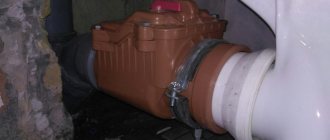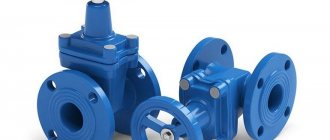The sewerage system requires the installation of devices that isolate wastewater tanks from residential premises. A water seal for sewerage is used as such protection. Those who lay sewer lines need to know what these devices are in order to ensure the reliability of the drainage system without errors.
Why is it needed and where is it used?
A water seal is needed to prevent the penetration of gas from sewer pipes into the rooms where devices connected to the sewer are located. The same problem can be solved by a household pneumatic valve installed in the drain network.
Its operating principle is based on mechanically blocking the sewerage section with plugs.
If solids become trapped between the wall and the plug, the valve's performance will be reduced. In contrast, a water plug in the siphon will, under any circumstances, completely block the drain hole into the sewer.
Installing a siphon with a water seal not only performs a protective function, but also solves additional problems:
- reduces the sound volume during drainage;
- serves as a sump - large particles of debris settle at the bottom of the siphon;
- prevents bacteria and insects from entering living spaces through the sewer system.
Water protection is used in all plumbing fixtures. Water seals for sewerage are installed in the bathhouse, as well as in the bathtub and shower. The toilet is the only device that does not require connecting a water seal. Its design involves the use of a built-in siphon to remove waste.
Briefly about the main thing
A dry or hydraulic seal is one of the elements of an in-house sewage disposal system that prevents the appearance of unpleasant odors from sewer pipes in the room. Typically, the device retains water, which prevents the smell from entering the room from the waste pipes. The dry version is equipped with a membrane, float or pendulum that blocks the sewer hole.
Manufacturers produce elbow, bottle, corrugated, double-turn hydraulic siphons and models with overflow. Depending on their design, they are installed under sinks and bathtubs. A specific model is selected taking into account the size, type, number of drains, and the material used for manufacturing - metal or plastic.
Ratings 0
Device and principle of operation
Hydraulic valves are a device with a bend in the shape of the letter U. One end of it is connected to the drain hole, and the other is cut into the sewer at a right or acute angle.
Structurally, the rounded part of the pipe is located below the drain and tie-in into the sewer.
The action of the law of communicating vessels forces part of the drained water (hydraulic seal) to always remain at the bend and cuts off the access of odors from the sewer to the indoor air: toilet, kitchen, bathroom.
The water seal device can be located in a deep glass. The drain pipe enters it from above, and the spout into the sewer is located on the side above the bottom. The principle of operation of this design is the same as that of a siphon - protecting premises from unpleasant odors by creating a barrier of water.
Since waste water is constantly drained, the water seal fluid does not have time to stagnate. The disadvantage of water protection appears during prolonged inactivity of the drain. During this time, the water may evaporate, and an unpleasant odor will penetrate into the apartment.
In addition, the vacuum created by the liquid flowing through the riser can suck water out of the siphon. To eliminate this phenomenon, it is necessary to supply the sewer with a drain pipe or a vacuum valve.
Types of water seals
Based on their design features, the following types of hydraulic locks are distinguished:
- geniculate;
- bottled;
- double-turn;
- corrugated;
- stormwater
Water seals for sewerage are available in 110 and 50 mm versions. In addition to these, in some cases dry seals are used.
Knee
The name of this species comes from the shape of the device - a bend reminiscent of a bent knee. Such siphons are made of plastic or metal. This guarantees their resistance to damage.
Elbowed sewer water seals are produced in two types - a monolithic elbow with castle nuts and seals, and prefabricated ones, consisting of separate parts. This design makes it possible to comfortably position the siphon and adjust its pipes to fit appliance drains and pipeline entries into the drain system.
The advantage is the small size. Due to their small dimensions, siphons are installed for hydraulic valves on sinks and bathtubs, the drain of which is low above the floor.
Bottle type
Using bottle siphons, water protection is installed under sinks in kitchens. The reason is the special design of the device. From the sink, the drain pipe goes directly into the body, made in the form of a bottle. The exit hole is cut into the side wall under the top of the housing. The space from the bottom to this hole is always filled with water.
The advantage of this type of hydraulic valves in the sewer system is a collapsible body, the lower part of which acts as a sump. If a lot of solid particles have accumulated in it and they block the flow of water, then the sump is easily disconnected from the body and cleaned. After cleaning, the housing and sump should be washed with hot water and detergent to remove fat deposits.
Double-turn water seal
A double-turn or pipe siphon is shaped like a knee device. The design feature of the pipe device is two bends located opposite to one another. In old structures made of cast iron, a removable hatch was installed in the upper bend to remove blockages.
Modern devices are made of plastic or chromed metal. They are equipped with a mesh to retain waste, and a removable elbow is used instead of an inspection hatch.
Double-turn water seals are installed on sinks, urinals, floor bowls, and washbasins.
Corrugated siphon
The easiest way is to create a seal in a corrugated sewer pipe. Its most important advantages: the ability to bend in any shape and the length adjustable by compression and stretching. Corrugated siphons are convenient to use under bathtubs - in limited space it is easy to connect the drain with the entrance to the sewer. To maintain the bend, a plastic holder is included with the corrugation.
The disadvantage is manifested in the rapid clogging of the pipe folds with small debris, which leads to loss of flexibility and elasticity of the siphon. This is followed by the appearance of cracks and leakage.
To solve the problem, you can install a protective grille, or periodically replace the corrugation with a new one.
These parts are available and inexpensive. In both cases, the device will have to be disassembled, which is not always convenient.
Water seal for storm drainage
Siphons designed for draining wastewater from baths, showers or other bathrooms that are installed at floor level are called storm siphons. Structurally, they are similar to bottle siphons. The difference is insignificant - instead of a collapsible waste container, the storm siphon is equipped with a glass for collecting waste.
The design allows for easy removal from the storm siphon and cleaning of this part. To make cleaning accessible, removable protective grilles are placed on top of storm water seals.
Dry water seal
A water seal is ineffective against waste gases if water is rarely drained. The water plug evaporates and the drain pipe is no longer protected. Therefore, in a sauna, bathhouse and similar rooms, it is more practical to install valves without water - dry ones.
The advantage of a dry water seal for sewage is that it can act as a valve, preventing the reverse movement of sewage. For owners of apartments on the lower floors, drains can go through the plumbing if the riser in the basement for some reason stops letting them pass. Since the dry shutter operates without a water lock, it does not fail.
Dry seals are made in different types:
- float;
- membrane;
- pendulum.
Float devices are the most popular. An inverted floating glass acts as a float. Depending on the presence or absence of water, it opens or closes the hole in the sewer inlet. When draining, the float rises to the top of the receiving chamber, and the water goes into the waste pit.
After the flow of water stops and as it decreases, the glass falls to the bottom of the drain container and blocks it. Sometimes a ball is used instead of a glass, but this does not change the principle of operation of the shutter.
Membrane devices work simply - a silicone membrane is installed inside the case in the form of a flattened sleeve. The direction of water movement is indicated by an arrow on the body. When liquid is supplied, the membrane opens under the influence of the weight of the water, and when the flow is complete, it contracts again. Membrane devices operate with horizontal and vertical water flow. This type of valve is produced with a cross section of 32, 40 and 50 mm.
The pendulum shutter is used to block the drain hole and is a plate on the curtains or a damper that is returned to its original position by a spring. The waste water opens the valve with its weight and flows into the sewer. After the water passes, the damper, under the influence of its own weight or spring, closes the drain hole again.
General information
Sewage in the house can be a source of unpleasant odor, which is always present in it due to the activity of bacteria. If you directly connect sinks and other similar equipment to the sewage drainage system without installing siphons, the aroma from the pipelines will appear in the house.
The hydraulic valve is an important element of the intra-house sewerage system. It has a simple design, but allows you to prevent the appearance of unpleasant odors from sewage pipes in the room. After all, a water plug forms in it, which prevents the penetration of odors.
The part of the siphon where the water is located is always located below the drain hole. Therefore, liquid is retained in the device when water is not drawn. The part of the siphon with water has a curved shape. This design prevents the complete removal of liquid from the device.
When draining occurs, old water that is trapped in the curved part is displaced. This process cleans the device and prevents microscopic organisms from growing.
The principle of operation of a hydraulic valve using the example of a toilet bowl Source kupisantehniky.ru
A water seal is a sewerage element that also prevents water hammer. Due to their blocking, excessive load is not created on the pipes and the entire system as a whole.
With correctly selected water seals, the period of proper operation of the sewer network increases. Therefore, the level of comfort in the house does not decrease.
When the installed siphon is not used for a long time, the liquid evaporates, which is retained in its curved part. For this reason, after a certain time, an unpleasant aroma from the sewer will appear in the room. The smell will also be felt during the first flush after a long period of not using the plumbing equipment.
On a note! If an unpleasant odor appears from the sewer network, it is necessary to check the presence of water in the curved part of the siphon. It can disappear not only as a result of evaporation, but also due to leakage if the device bursts. The problem is solved by installing a new element.
Installing a new hydrosiphon Source multiscreensite.com
How to choose
Siphons are selected to provide water seals according to the material and for specific plumbing fixtures. The most common option is plastic. They are easy to install and are sold at a low price. Siphons made of chromed metals and cast iron are also used, but the conditions for their installation and maintenance are more complicated than those of plastic ones.
You should consider which plumbing fixture will protect the water seal. It is best to pass drainage from the kitchen sink through a bottle-type device - this is where drain pipes become clogged more often, and it is easier to remove dirt with this type of siphon. Sinks are equipped with overflow protection, so a knee valve is suitable for them.
It is more profitable to choose products made of polypropylene or chrome-plated metal.
If you plan to use two sinks in parallel, then you need to install a device with two drains with one siphon.
The selection of a drain valve for a bathtub depends on the height at which the bowl is located above the floor. The siphon is chosen so that it fits in this space. Bent and corrugated valves work well in bathrooms. Protective devices are chosen in a similar way for other plumbing fixtures and for the bathhouse.
If there is a danger of the valve breaking, it is better to ensure its operation by installing a vacuum valve.
